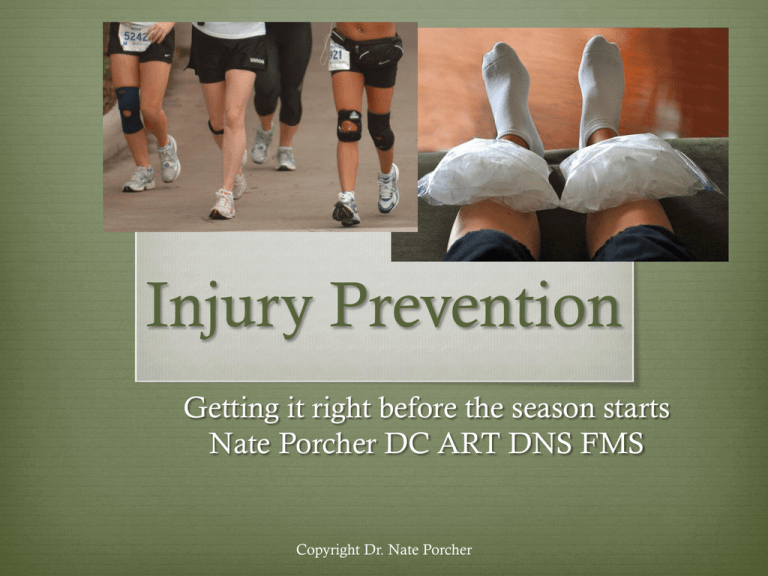Notes - ITCCCA
advertisement

Injury Prevention Getting it right before the season starts Nate Porcher DC ART DNS FMS Copyright Dr. Nate Porcher Quickly About Me Prospect HS Alum Taylor University in Indiana – Track and FB Letterman Trinity International University in Deerfield – FB and Baseball Letterman National University of Health Sciences –Doctor of Chiropractic Hundreds of hours of postgraduate training in Functional Evaluation, Rehabilitation, Soft Tissue Correction, Strength and Conditioning Spent some time working in the training room with athletes at Benedictine University in Lisle Sports Medicine-Focused practice in downtown Arlington Heights— Foundation Sport & Spine Copyright Dr. Nate Porcher Topics Covered Common Injuries—why they occur Prevention of Injuries The Role of the Diaphragm in Core Stability Tri-planar Training for Sagittal Plane Athletes SHIN SPLINTS!!!! The Benefits of having a sports healthcare practitioner as part of your team—PRESEASON SCREENING, management of injuries that have occurred Copyright Dr. Nate Porcher How often do injuries occur? The most common running injuries Shin splints/stress fractures Hamstring or other muscle pulls/tears Plantar fasciitis/Heel pain Patellar Tendonitis/knee pain IT Band Syndrome Low back stiffness/pain What other injuries plague your program? Copyright Dr. Nate Porcher What are your current methods of Injury Prevention? How have these reduced soft-tissue injuries? Once injuries occur, how are you managing them? Copyright Dr. Nate Porcher Main cause of most of these injuries In General: OVERUSE (of a bad motor strategy) In Particular: IT Band Syndrome—weak core/glutes Shin Splits—more complex (will cover in depth later) Patellar tendonitis—weak glutes, poor core/pelvic stability, weak tibialis anterior, and dominant quads/hip flexors Plantar Fasciitis—weak foot intrinsics, weak tibialis anterior, poor hip extension Low Back Pain—weak core/glutes/improper motor patterns Copyright Dr. Nate Porcher The “Intangibles” Anatomy Fallen Arch, hip anteversion, integrity of connective tissue in the body, etc, etc. Body Chemistry/Nutritional Status Copyright Dr. Nate Porcher Re-Envisioning the CORE Copyright Dr. Nate Porcher The Role of The Diaphragm Is it just for breathing? Let’s take a closer look at the design of the diaphragm In my clinic— diaphragm function tested on day one, and diaphragm rehab starts day one. Copyright Dr. Nate Porcher One muscle, two amazing functions Breathing function Postural function Diaphragm contracts/ drops Diaphragm contracts/drops Decreased pressure in thoracic cavity Pelvic Floor contracts, stiffens Air rushes in O2/CO2 exchange happens Abdominal muscles reflexively contract (TrA, Obliques, QL, rectus abdominus Diaphragm relaxes Elasticity of ribs and lung tissue forces air out Intra-abdominal pressure increases greatly Punctum fixum is created Copyright Dr. Nate Porcher Creating the Punctum Fixum What’s the big deal? Why the diaphragm? Punctum Fixum – FIXED POINT i.e. intra-abdominal pressure stabilizes the anterior hip capsulethe glute medius attaches to the hip and pelvisstable hip increases glute med firing/stabilability i.e intra-abdominal pressure stiffens the abdominal fascia, T/L fascia, and stabilizes the rib cagecreates a solid basis for the obliques to pull up and over Need an example? Copyright Dr. Nate Porcher The role of the ribcage position over the pelvis Intra-abdominal pressure is compromised by poor posture This will cause buckling of the lumbar spine and poor core stability, poor base for oblique systems Copyright Dr. Nate Porcher How do you know it’s not working Observations: GOOD NOT AS GOOD How do you know it’s not working? Here are a couple of tests: Diaphragm Test with Breathing IN Copyright Dr. Nate Porcher Another test Copyright Dr. Nate Porcher One more test Intra-Abdominal Pressure (IAP) Test Copyright Dr. Nate Porcher How to destabilize the core: Situps, Crunches, V-ups, supine toe-touches THROW THEM OUT!! “The spine only has so many bends before a disc will herniate.” Stu McGill –University of Waterloo 3,350 Newtons of compressive force in the disc with them PLUS, They’re NOT FUNCTIONAL!! Copyright Dr. Nate Porcher Some basic exercises for stabilizing the core Use (some of the tests) as the exercises Have athletes gain awareness/ability to use the diaphragm first as a muscle of respiration Have them start to gain awareness/ability of the postural/stabilization function Side bridge/plank progression 4-way bench planks Supine IAP test in Triple Flexion (knees, hips, and ankles at 90 degrees Can add physioball as an advancement Copyright Dr. Nate Porcher More Exercises Bird Dogs– must maintain proper stabilization strategy of core and KEEP BREATHING. Complex exercises Variations of Side Planks (remembering to have intraabdominal pressure) Once the Core is Solid Implementing the role of the oblique muscle slings Dynamic movements using the slings to move Chops, Lawnmowers (for power) i.e. throws, running, etc. Dynamic movements using the slings to stabilize i.e. throws, running, etc. Copyright Dr. Nate Porcher Continuing Onto Global Exercises This idea of increasing abdominal pressure NEVER GOES AWAY with any exercise! Guess why these guys wear belts when lifting? Triplanar Training for the (primarily) Sagittal Plane Athlete Copyright Dr. Nate Porcher What exactly does that mean? Review of Planes of Movement Sagittal Coronal/Frontal Transverse Examples of Poor Stabilization Another Example Another Example! Combined Frontal/Transverse Plane Instability Contrasting Those Examples With Olympic Athletes Two Bads and One Good Making Basic Lifts Tri-planar Sometimes with movement, sometimes with stability Use Dumbells or (better yet), Kettelbells Squats Goblet, 90, Overhead Lunge. 90, overhead Single-Leg RDL Copyright Dr. Nate Porcher Making it even better with Therabands® Lunges, step-downs with Therabands® Tri-Planar Squats (from the last few slides) Copyright Dr. Nate Porcher Tri-Planar Plyos Jumping Lunges Tri-Planar Box Jumps Burn-outs Copyright Dr. Nate Porcher SHIN SPLINTS Dr. Nate Porcher DC ART DNS FMS Why do all my athletes have shin splits? Medial Tibial Stress Syndrome: 1st things 1st—Rule out Stress Fracture/Compartment Syndrome 2nd—Understand the tissue pathology 3rd—Determine the appropriate course of action 4th—Implement the appropriate course of action Copyright Dr. Nate Porcher RSI of soft tissues in general and shin splints in particular RSI—Repetative Strain Injury Copyright Dr. Nate Porcher What’s the latest Research Say? Bennet et. al. The relationship between isotonic plantarflexor endurance, navicular drop, and exercise-related leg pain in a cohort of college crosscountry runners. International J Sports Phys Ther. 2012 Jun; 7(3): 267-78. Greater Navicular drop tend to have greater chance of leg pain History of shin splints in last month 12X more likely to re-develop In other words... Yuksel et. al. Inversion/Eversion Strength Dysbalance in Patients with Medial Tibial Stress Synrome. J Sports Sci Med. 2011 Dec; 10(4): 737-42. Prolonged pronation will lead to longer lasting traction stress on the soleus fascia, which in turn can facilitate the development of MTSS (all due to stronger evertor muscles) Also, likely due to less eccentric power/strength/endurance of the medial soleus Rathleff et. al. Dynamic midfoot kinematics in subjects with medial tibial stress syndrome. J Am Podiatr Med Assoc. 2012 May-Jun; 102(3): 205-212. More navicular drop, faster navicular drop Copyright Dr. Nate Porcher My thoughts... If they need orthotics—send them, this will help with navicular drop velocity and depth. Still—orthotics are not the final solution, but one piece in the puzzle! Should be combined with “short foot” training, coronal plane glute med training =less contralateral hip drop, less internal rotation lower leg, less pronation of the midfoot. Isokinetic strength does not equal plyometric power. Eccentric strength of the lower shank external rotators (i.e. GLUTE MED/MIN) is a driving force behind decreasing overpronation in the foot. Exercises that get the soleus to adapt rapidly from an eccentric muscle to a concentric one should be implemented (plyos, blind box drops, tri-planar burnouts Correct tissue pathology, because ice, rest does not heal fibrotic, tight, painful scar tissue. Send them for this too! Copyright Dr. Nate Porcher How to I break the cycle? Break up the adhesions: Best two ways: ART® (Active Release Techniques®), and FAKTR® (Functional and Kinetic Treatment w/ Rehabilitation®) Correct joint restrictions to proper biomechanics Subtalar eversion restoration SI joint mobilization (if it’s no moving, the glute med won’t fire properly!!) Copyright Dr. Nate Porcher How do I break the cycle? Dampen the inflammatory cascade: With proper nutrition (Diet high in Omega-3 FA, avoidance of high Omega-6 foods) Re-Train: The short foot muscles (dampen forces through the ML arch and T Arch) The G Meds/Mins to dampen internal rotation forces experienced from ground reaction forces. Plyo/reaction strength/power of Gasroc/Soleus mm. Any other multiplanar instabilities with tri-planar training. Use Corrective Taping, when warranted KinesioTex Tape—change muscle firing, help drain. Copyright Dr. Nate Porcher Pre-Season Functional Movement Screening Gray Cook—The guy behind the FMS™ screens “What often happens is people are putting exercise and performance on top of dysfunctional movement, which can impair performance and cause injuries” Copyright Dr. Nate Porcher Who should get screened? All athletes who are pain-free, and wanting to perform at a high level. (Sound familiar?) WHY? The screens identify imbalances side to side The screens identify the weak link in the chain The screens point to corrective exercise strategies to help optimize later training and prevent injury (The athlete who experiences pain with the screen should be referred to a healthcare provider) The screen should always be used as a follow-up tool to monitor progress Copyright Dr. Nate Porcher How to implement the screen Pre-season screening by certified FMS practitioner Develop categories for athletes with different types of dysfunction to fit into Develop programs for those athletes--add it into their resistance program Be judicious about what full-body lifts to use with athletes who have poor dynamic function, ease them into them once base function is corrected/core is strengthened When an athlete has pain—send them for professional eval RIGHT AWAY Don’t let the injury progress to a season-ending situation! Copyright Dr. Nate Porcher Thank you! Copyright Dr. Nate Porcher Image Resources Title page:http://www.erinchapmanfitness.com/wp-content/uploads/2013/05/shin-splints-ice-1.jpg http://www.runaddicts.net/wp-content/uploads/2010/06/injuries-664x300.png Diaphragm diagram: http://balancedbodymind.com/wp-content/uploads/2013/10/ijspt-08-062-f002.jpg Diaphragm diagram 2: http://www.muscleimbalancesyndromes.com/wp-content/uploads/2012/04/Kolar-inspiratory.jpg Turtle Shell 6 pack:http://www.ign.com/boards/threads/attn-people-that-give-fitness-advice-to-others-on-the-boards.452450163/ Exercises: http://www.gymra.com/blog/strength-training-for-running/#!prettyPhoto Westside Barbell: http://www.criticalbench.com/westside-barbell.htm Running: http://www.google.com/url?sa=i&rct=j&q=&esrc=s&frm=1&source=images&cd=&docid=Eck7FY0cvHEasM&tbnid=gT32iHT1v3f2M:&ved=0CAEQjxw&url=http%3A%2F%2Fwww.iachiropractic.com%2Fblog%2F10-things-i-learned2012%2F&ei=Vo3NUvoRho3aBYitgJgK&psig=AFQjCNEaDgmd43LiMONBGmbeOiEbF3Sn7A&ust=1389289159110539 Diaphragm tests: All copyright Prague School http://runnersconnect.net/wp-content/uploads/2013/05/RC8_GluteMedius_Role-300x195.jpg Shin splits:http://www.drxuacupuncture.com/wp-content/uploads/2011/07/Fig-7.23.jpg Copyright Dr. Nate Porcher How to reach me: Nate Porcher DC ART DNS FMS Email: nathanporcherdc@gmail.com Office: (847) 342-3000 Web: www.foundationsportspine.com Location: 115 N. Arlington Heights Road Suite 104 Arlington Heights, IL 60004 Copyright Dr. Nate Porcher







